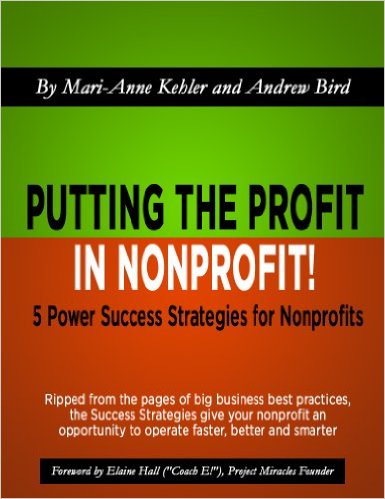And By: Andrew Bird (Marketing and Communications Consultant)
(Excerpt from their book, Putting the Profit in Nonprofit! 5 Power Success Strategies for Nonprofits)
Donors can’t give you money if they don’t understand who you are and who you help. They also can’t give you money if YOU can’t effectively explain who you are and who you help! Why does your organization exist? Whom do you serve? In big business, we call this a mission. No matter what you call it, can every volunteer, staff member and board member sum up your organization’s mission in a sentence or two? If they can’t, you’ve just identified your #1 barrier to success.
Focus on your key message
In business, a clear message is the building block of strategic planning. Strategy is what then allows each unique brand to develop. The brand’s strength and clarity translate to more sales, and profits are the goal. The team comes together to chart the best course to reach the goal. Everyone there is getting paid, and getting paid depends on making a profit. It’s simplistic, but no smart businesses try to be all things to all people.
But nonprofit organizations are different. They tend to have a mix of people involved who may have their own ideas and needs that translate into different priorities. Only a few may be getting paid, and even they are not solely motivated by the money. The mission can expand to satisfy too many needs and too many people — it can get muddy, and the primary goals start to get lost in translation. The late business guru Stephen Covey once said, “The main thing is to keep the main thing the main thing.” When businesses discover they have ventured too far from their core goals, they realize they need to re-group and re-focus. A great example of this is Apple after Steve Jobs left — management decided to widely diversify, and the stock price crashed. When Jobs returned, he immediately cut the product line to the core. Another example is when Starbucks decided to offer grilled sandwiches — when customers smelled the heavy cooking aromas, they complained. They wanted Starbucks to smell like coffee, and Starbucks quickly made the change. They went back to basics and profits boomed, once again.
So getting known is essentially about focus. How can you develop a strong, core message that can be repeated by everyone associated with your organization? How do you make sure your message has heart, meaning and is compelling? There are three clear areas we suggest you focus on — what, how, who:
- Message — what your organization does to help others
- Goal(s) — how you’ll focus
- Communicating the message and goal(s) — who you’ll tell
A clear, impactful message helps your organization in everything you do — attracting volunteers, motivating staff, recruiting board members and of course in fundraising.
The message
You’re at a cocktail party (or lunch with a new friend, or watching your kids play soccer, or in a job interview) and someone asks you, “So, what do you do?” You might recite your job title, mention your kids, say that you’re in school or describe a hobby or leisure passion.
When you tell someone you are involved with a nonprofit, they inevitably ask, “So what do THEY do?” It sounds like an easy question, but people are likely to launch into an explanation of why they’re involved (“My child has autism, and I got involved to give back,” or “I love going to the theater, and I love being around theater people,” or even “I’m trying to get into college, and I need experience for my application”). Yeah, but what does the nonprofit DO?
By defining a shared purpose and a common message, you are creating instant word of mouth and planting your organization’s message and goals into peoples’ heads. The simpler the better. In business, we call it an elevator pitch — if you’re riding in an elevator with someone, how would you describe your business quickly, before the elevator doors open? Businesspeople also call it a Value Proposition; for nonprofits, it’s commonly called a Mission Statement. Let’s take it a step further and call it an Impact Statement.
Brainstorm your Impact Statement
Gather as many of your organizations’ stakeholders in one room as you can — staff, volunteers, board members, even the people who are receiving help from your organization’s mission. It could be a virtual room if you’re all spread out, but in person is best so that ideas can flow and feed off of one another.
There are no right or wrong answers in a brainstorming session — write it all down and sort it out as a next step. Ask for statements that reflect the effect or impact of the organization’s services and describe how the community’s needs are being met. Answer key questions with your statements:
- Why was our organization founded?
- What do we do better than anyone else?
- What is (or will be) our biggest achievement?
- How will peoples’ lives be better after we provide our service(s)?
- What emotions will people feel after they’ve been helped by us?
It is extremely tempting to focus on how great your organization is and list all that you’ve accomplished. Don’t do it. In the marketing world, what sways customers is the clear impact you have and the transformation you can expect by using these services.
In the end, you’ll have an easier path to finding the core mission, one that can be repeated by everyone in the organization. We’re all leading busy lives and can be easily distracted by multiple messages at any given time — so we suggest you find ways to repeat the mission as part of every communication, far beyond the point of redundancy, to allow your audiences to “get it.”
3 key takeaways:
- The most important message is about how the customer will be impacted by your service
- Great Impact Statements are about focusing on a simple message that can be easily communicated and repeated
- The Impact Statement is the core building block for your brand
“If you can’t explain it simply, you don’t understand it well enough.” ~Albert Einstein
About Mari-Anne Kehler (Chief Marketing and Strategy Officer, GHJ)
Mari-Anne leads the Firm’s business development and marketing strategies. She has over 30 years of experience as a high-impact leader who successfully expands business through action by using core skills of teaming, coaching, strategy development, program execution, measurement and innovation. She has an integrated client-centric and industry approach with experience in professional services, finance, consumer business, entertainment and media. Mari-Anne’s nonprofit work focuses on organizational problem solving, leadership coaching, capacity building, constituent development, communications and global and grass-roots advocacy. For more on Mari-Anne, click here.
About Andrew Bird (Marketing and Communications Consultant)
A former Deloitte & Touche marketing executive, Andrew ultimately served as Leader of Strategic Marketing Initiatives in the U.S. for the firm. He has over 25 years of experience in nonprofit operations, content marketing, complex project management, marketing strategy, leading diverse teams and developing future leaders.
A true believer in giving back, over the years Andrew has founded two nonprofits, served as executive director of three and has been a board member of five. He currently serves on the board of Global Brigades, a $15 million+ nonprofit that sends thousands of student volunteers on overseas volunteer missions yearly, and also is deeply involved in expanding the reach of Global Brigades’ successful fundraising technology platform, www.Empowered.org. A long-time supporter of mentorship programs, he founded a regional mentoring group at Deloitte and was co-founder of the firm’s highly successful and ongoing National Senior Manager Advisory Council group.
Andrew is recognized as an authority on proposal and grant strategy and implementation. His achievements include winning the Marketing Achievement Award from the Association of Accounting Marketing, serving as a keynote speaker on proposal writing for such organizations as the Independent Writers of Chicago, and publishing a series of articles on proposal/grant strategy and implementation for Svoboda’s Business Magazine. He won the Deloitte Award for Distinction and Excellence from the National Consumer Business Practice and has written proposals worth over $1 billion in new business. He is currently a content marketing consultant to nonprofits and global businesses.
He earned his BS in Business Administration from New York University, an MBA in Finance from Loyola University, and an MA in Spiritual Psychology from the University of Santa Monica (USM), where he continues to volunteer regularly. For USM, he was also a founding team member of SpiritWalk, a fundraiser that has earned over $500,000 for students facing financial challenges since 2010. This event is ongoing, and continues to be executed each year by graduating students.



